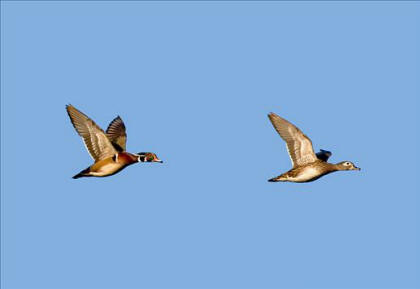Lifestyle
Nutrition
The Wood Duck’s grouping into the Subfamily Anatinae means
that the bird generally feeds on the surface of the water, as opposed to diving
deep below, as many ducks do.
Because
of this, the diet of the bird is somewhat limited. Acorns and other small seeds
found along the shoreline serve as a primary source of sustenance for the bird,
but the Wood Duck is by no means an Orthodox herbivore. Wood Ducks have been
known to feed upon several other phyla, in fact. For Arthropods, the Wood Duck
chooses to feed upon crustaceans and insects such as crayfish and dragonflies
respectively. Within the Mollusks, the Wood Duck wastes no time in devouring
small snails and clams. And finally, when feeling especially daring the Wood
Duck even feeds within its own phylum, the Chordates. The prey in this section
includes small fish, frogs, and salamanders unlucky enough to be spotted by this
dazzling bird.
Competition for a limited number of resources is a reoccurring theme in nature, however, and the Wood Duck is no exception. For many birds that choose not to migrate, the winter can be a testing time. With acorns buried beneath a layer of snow, the Wood Duck is often forced to find other means of obtaining food. For many, this means finding open water to catch small fish, or searching the bottoms of ponds for seeds and other nourishment.
Parasitism
Like many species of waterfowl, the Wood Duck serves as a host to some parasitic organisms. In a study published in the Journal of Wildlife Diseases put forth to discover the identities of the primary blood parasites in Wood Ducks, the two most common found within the Northern Wood Ducks populations sampled were Haemoproteus nettionis, and Microfilaria, the juvenile form of filarial worms. A third parasite Leucocytozoon simondi, is a parasite known to infect the red blood cells of the Wood Duck, depleting its transfer of oxygen and nutrients through the blood, causing anemia.
Another, unexpected form of parasitism involves the Wood Duck as the parasite rather than the host. In some instances during the nesting seasons, some hens have been known to abandon their eggs in the nests of another. These "dump nests" sometimes contain upwards of 30 or more eggs in them but occasionally produce healthy broods when a hen chooses to care for them as if they were all her own.
Migration
 Although
many Wood Ducks choose not to migrate, the species in general is known to
migrate south once the cold season begins moving in. Beginning in October, and
generally lasting until the close of November, the Wood Duck’s migration does
not all occur at once like that of Canadian Geese, but in more intimate groups,
dropping into wetlands of the South in pairs and small flocks.
Although
many Wood Ducks choose not to migrate, the species in general is known to
migrate south once the cold season begins moving in. Beginning in October, and
generally lasting until the close of November, the Wood Duck’s migration does
not all occur at once like that of Canadian Geese, but in more intimate groups,
dropping into wetlands of the South in pairs and small flocks.
Next, learn about the reproductive strategies of Aix sponsa.
Questions or comments? Email me at larson.chri@students.uwlax.edu